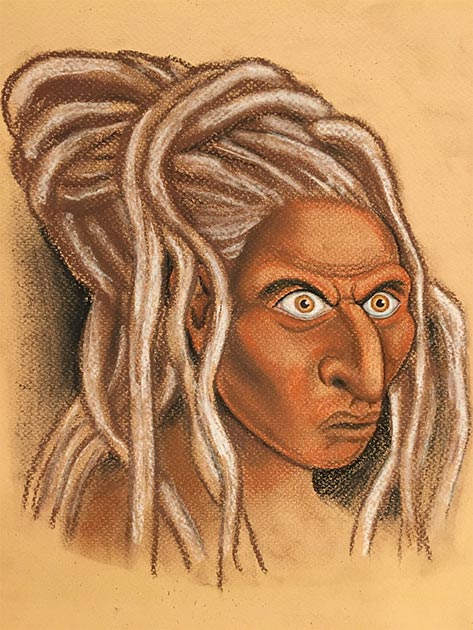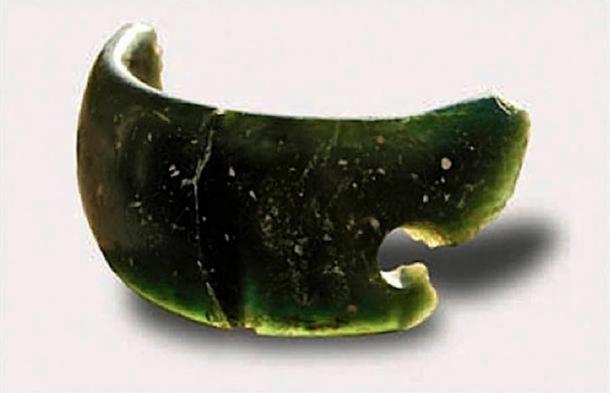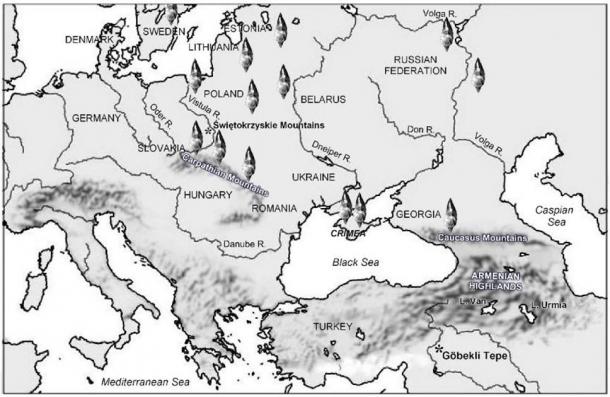
The Far-Reaching Realms of Denisovan Ancestry Stretch to Iceland
This week it was announced that a new genetic study published in the journal Nature shows that the genomes of over 27,000 Icelanders display an admixture of modern human and Neanderthal DNA, along with a noticeable trace of Denisovan ancestry that was not expected at all. These findings suggest that past introgression took place between the direct ancestors of Icelanders, most obviously archaic Norwegians, and either Neanderthals carrying Denisovan DNA or Neanderthals and Denisovans separately. Similar results have not been noted in modern-day Scandinavians, either due to insufficient study of their genomes, or the fact that any residual Denisovan DNA has been diluted through interbreeding with other European groups with no traceable Denisovan ancestry.
So Denisovan DNA among modern-day Icelanders either came from Neanderthals, through their own introgression with Denisovans, or, alternately, the ancestors of the Icelanders had themselves encountered Denisovans somewhere in the ancient world, this all taking place many thousands of years before the establishment of the first Viking colony on Iceland during the ninth century AD.

The discovery of Iceland by the Vikings in 872. (Public Domain)
Either solution could be right, although both support the view that Icelanders, who stem from a firmly established Norwegian background, were the inheritors of Denisovan ancestry. This probably has its roots as far east as the Altai Mountains of Siberia, where evidence for the existence of the Denisovans was first determined in 2010 following the sequencing of the genome of a human-like finger bone found in the famous Denisova Cave by the Max Planck Institute in Leipzig, Germany.
This proved to belong to a previously unknown hominin lineage related to, but not the same as, the Neanderthals. An examination of the Altai Denisovan genome showed that some modern human populations—primarily in southern, eastern, and southeastern Asia, as well as in Melanesia, Oceania, and Australia—have genes displaying anything between 3 and 6 percent Denisovan ancestry.
- Two Faces of a Denisovan Revealed and Explained
- 45,000-year-old Cave Lion Figurine Uncovered At Denisova Cave

Face of a Siberian Denisovan by artist George Hernandez. (Image credit: George Hernandez)
Key Firsts
Archaeological excavations from the same occupational layer as the discovery of the finger bone in the Denisova Cave have also produced a number of cultural artifacts clearly showing the extraordinary technical innovation of the Denisovans. They include a 45,000-year-old bracelet made of green chloritolite that, in addition to being perfectly symmetrical and highly polished, has a hole bored through it displaying evidence of high-speed drilling. From the same occupational layer (Layer 11) have come fragments of the earliest known musical instrument in the form of a whistle or flute, suggesting that the Denisovans had a basic knowledge of music and musical notes, as well as a bone needle complete with eye hole probably used to create tailored clothing.
The same occupational layer has also provided an exquisite example of paleoart (that is, art from the Paleolithic age). It takes the form of a carving of a mountain lion made from wooly mammoth ivory. Incredibly, it has a series of incised markings in sequences suggestive of a basic knowledge of the movement of the sun and moon.
In addition to this, in 2019 it was announced that the presence of a highly developed blade tool industry at the Denisova Cave, found also at other cave sites in the region, was most likely developed first among the Denisovans before being adopted by the earliest human groups to establish settlements in nearby central Mongolia circa 30,000-40,000 years ago.

vDenisovan Ancestry in the Urals and Beyond
Prior to the present genetic study—undertaken by scientists at deCODE genetics along with colleagues from the Max Planck Institute and universities in Denmark and Iceland—the only European human group known to have Denisovan DNA are the Finns, gained most likely through their estimated 7 percent Asian ancestry. This was probably derived from the westward migration of Asiatic peoples coming across the Ural Mountains from North Asia. Icelanders are likely to have gained their own Denisovan ancestry via a similar route – so-called Uralic or Finno-Ugric language speaking peoples of Asian descent crossing the Ural Mountains and moving westwards into Europe soon after the end of the last ice age, circa 9600 BC.
Archaeological discoveries in both Finland and Scandinavia show that the earliest modern human groups to occupy the region following the withdrawal of the ice sheets into more northerly Arctic latitudes carried a sophisticated stone tool industry known as the Swiderian or Post-Swiderian with them. This included the manufacture of long, slim blades, as well as much smaller tools called microliths. What is so significant about this stone tool technology is that it is thought to have emerged from the area of central Mongolia, most obviously among the same settlements that our earliest ancestors encountered Denisovans for the first time.
The discovery that Icelanders, like the Finns, possess at least some Denisovan ancestry now adds weight to the theory—put forward originally by the present author in 2018—that the Denisovans’ blade tool technology was carried from Mongolia westwards across the Ural Mountains into northern and central Europe, where it was adopted by Swiderian and Post-Swiderian cultures such as the Kunda and Butovo.

Location of the discovery of Swiderian points across Europe. (Image credit: Andrew Collins)
The Lost World of Doggerland
Another speculation offered by the findings of this new genetic study is the extent to which Swiderian and Post-Swiderian groups impacted on western Europe. For instance, there is tentative evidence that the former inhabitants of Doggerland, the great landmass that formally linked Denmark with Britain before being drowned by the rising waters of the North Sea sometime between 6000 BC and 5500 BC, bore striking similarities with the Post-Swiderian Kunda culture.
Moreover, there is already compelling evidence that, before its final fragmentation, Doggerland’s mysterious inhabitants developed megalithic capabilities, erecting standing stones and perhaps even more complex monuments. Despite lying beneath tens of meters of water, the existence of these monuments has recently been confirmed through underwater radar surveys of the Dogger Bank, the name given to the former Doggerland landmass.

Map of Doggerland as it might have looked around 10,000 years ago. The area known as the Outer Silver Pit is thought to have been the center of the landmass’s Mesolithic community some 10,000 years ago. (Image credit: Andrew Collins)
Orcadian Genesis
So what happened to Doggerland’s megalithic culture? Most probably its migrants set up elsewhere, having reached suitable new territories beyond the limits of its own doomed world. But where exactly? The answer would appear to be the Orkney Mainland, the largest of the Orkney Isles, which lies off the north coast of Scotland.
Not only is this the site of the earliest preserved stone circle in Britain in the form of the enigmatic Stones of Stenness, built circa 3100 BC, but recently, at the nearby Ness of Brodgar archaeological excavations, an extensive and highly sophisticated Neolithic complex has been uncovered. It was almost certainly responsible for the emergence not only of the island’s advanced megalithic culture, but also for the rapid spread of the stone circle-building tradition that swept across Britain and Ireland circa 3000-2500 BC.
- Modern Humans Could Have Mated With Denisovans as Recently as 15,000 Years Ago
- Did Autism Make the Denisovans Savants of the Prehistoric Age?
Evidence for the presence of Doggerland’s suspected Post-Swiderian culture in the Orkney Isles has been the discovery there of stone tools and projectile points more-or-less identical to those of the Kunda culture of northern and central Europe. These have been found at various sites on the Orkney Isles. One Swiderian-style projectile point was even found within the interior of the Ring of Brodgar stone circle, which lies immediately to the northwest of the Ness of Brodgar excavations
Indeed, this is itself a crucial link to the greater antiquity of the island’s megalithic culture, since excavations at the Ness of Brodgar are uncovering firm evidence that beneath the foundations of its earliest Neolithic buildings are even older structures belonging to the Mesolithic age.

The Ring of Brodgar, Orkney Mainland. (Image credit: Andrew Collins)
Further suggesting a Mesolithic presence on the archipelago is the recent discovery of what appears to be a circular henge monument in coastal waters off the Orkney Mainland. This important development in establishing the Orkney Isles’ greater antiquity was made under the direction of archaeologists Dr. Caroline Wickham-Jones and Dr. Richard Bates with the patronage and good will of the Discovery Channel’s popular show “Expedition Unknown”, presented by Josh Gates.
The sheer depth at which this monument, dubbed “motherhenge”, is located makes it clear it belongs to an age prior to the establishment of the present sea level sometime around 3000 BC. This implies that the structure—located in the Bay of Firth—is most likely early Neolithic in age and dates to around 4000 BC. If so, then it seems plausible that following the sinking of Doggerland around 5500 BC, its megalithic culture shifted its operations to Scotland’s Orkney Isles, which then went on to influence the foundation of Britain’s own stone circle-building tradition at the start of the Neolithic age.
The Role of Viking Voyages
The reason for the emphasis here on the Orkney Isles is its connection to Iceland, located some 850 kilometers (528.17 miles) to the northwest. Viking voyagers sailing between Norway and Iceland would usually dock at both the Orkney Isles and the Faroe Isles to take on supplies and rest before the onward journey, thus establishing a lasting relationship between the inhabitants of Scotland and Norway. This maritime and cultural relationship between Iceland and the Orkney Isles has remained strong ever since, the two even sharing rites and rituals surrounding the use of megalithic monuments.
For instance, the Orcadian inhabitants of the Orkney Mainland would gather at the Stones of Stenness to swear oaths and allegiances, and to hold courts known as “things,” while Icelanders would gather to hold their own courts or “things” at a megalithic monument known as Domhringr, the "Doom Ring". Although this ring or circle of judgment was built only after the establishment on Iceland of the first Viking settlements, it forms part of a religious and cultural heritage that continued to unite Iceland not only with the megalithic traditions of Scandinavia, but also with the Dark Age and early medieval inhabitants of the Orkney Isles known as the Picts.
Much about the Picts remains obscure. They were certainly in Scotland at the time of the Roman invasion, and are known to have erected a large number of standing pillars decorated with beautiful and highly enigmatic carvings, which are today called Pictish stones. Most likely the Picts arrived in mainland Scotland and the Orkney Isles from northern Europe, where they would seem to have had links with the Finno-Ugric language speaking peoples of that region (Dunbavin, 1998).
For instance, the Christian monk and chronicler known as the Venerable Bede (672/3-735 AD) calls the Picts of Galloway in southwestern Scotland the “Niduari Picts” (Breeze 2003), with “niduari” deriving perhaps from one of two Finnish words, either noita (Lappish: noaida, Estonian: noid) meaning ‘witch’ or “shaman,” or noitua (Estonian: noiduma), meaning ‘to use magic’ and ‘to bewitch.’
Did these Finno-Urgic language speaking peoples carry with them not only the Denisovan DNA recorded today among both Finns and Icelanders, but also the lost technology of the Denisovans? Did this include not simply the means to create beautiful jewelry and sophisticated blade tools, but also the ability to erect stone monuments like those identified on the sea floor where the former Doggerland landmass once stood, and those to be seen to this day on the Orkney Mainland?

“A Young Daughter of a Pict” attributed to Jacques Le Moyne de Morgues from the 1580s. (Public Domain)
The Link to Göbekli Tepe
An important result that emerges from the discovery of Denisovan DNA among native Icelanders is the new understanding that not all human populations to benefit from introgression with Denisovans are found today in the eastern part of the Eurasian continent, or beyond that in Melanesia, Oceania, and Australia. Some Denisovan-modern human descendants made their way westwards into Europe. If this is correct, then did others reach southwestern Asia?
- Humans Competed with Fierce Animals for the Denisova Cave
- First Ever Skull Fragments of Denisovans Have Been Confirmed Found in Russia

The same blade tool technology that originated in Mongolia and eventually found its way into northern and central Europe, carried by Swiderian and Post-Swiderian cultures, also existed among the Epipaleolitic and Mesolithic peoples who came to settle on the northern shores of the Black Sea in current day Ukraine. What is significant is that these same stone tool technologies have been found in Anatolia at Pre-Pottery Neolithic cult centers such as Göbekli Tepe, having reached here across the Caucasus Mountains from Russia and Ukraine. Cross-cultural contact has already been proposed between the Mesolithic peoples of the Ural Mountains and the builders of Göbekli Tepe through comparisons made between the carved art of the latter and the so-called Shigir Idol of the former.
This new genetic study, when reviewed with the key evidence of Swiderian migration and technology, now provides even more reason to suspect that the engineering, sophistication and innovation that went into the construction of Göbekli Tepe, with its familiar T-shaped pillars set up in circular enclosures, might well have originated not just from the direction of the Ural Mountains, but also with Finno-Ugric language speaking peoples who were themselves carrying at least some Denisovan ancestry. Firm links also exist between certain words of the Kurdish language and the Finno-Ugric language group.
And while there is nothing concrete to conclusively prove these conclusions, it is strongly suspected that the connection between the megalith builders of Göbekli Tepe and indigenous peoples of an Uralic, Siberian, and even Mongolian ethnological and cultural background will only increase as more data becomes available on the Denisovan DNA present in modern-day populations.

Göbekli Tepe in southeastern Anatolia. Who built it, when and why? (Image credit: Andrew Collins)
Top Image: Did Denisovan ancestry reach European megalith builders? Source: adrenalinapura / Adobe Stock
Andrew Collins is a history and science writer. His most recent book is Denisovan Origins, co-authored with Gregory L. Little (Bear & Co, 2019).
References
Breeze, Andrew, 2003, “St Cuthbert, Bede, and the Niduari of Pictland,” Northern History 40:2 (September 2003), 365-8.
Dunbavin, Paul. 1998. Picts and Ancient Britons: An Exploration of Pictish Origins. London: Third Millennium Publishing.
















Comments
The comment from me is a reply to Skildude.
Birdlady
Nowhere in the above article does it say that the Vikings originated in Iceland. It says that the first Viking COLONY (i.e. colonised from Normark/Norway) was established there in the ninth century.
Birdlady
OK the Vikings weren’t from Iceland. They were from much farther East. As I recall from my world history course, many peoples were fleeing the Huns in the century or so before the Vikings actually started pillaging around Europe. It’s not unlikely, they moved to Scandanavia, to avoid the hordes, that they had probably heard tales of. Many tribes moved to Roman territory to hide from the Huns. Those that didn’t were conquered.
So in less that a couple hundred years the Viking population was probably large enough to start out to sea to find more resources.
This story while quaint just seems to ignore the fact that Vikings didn’t start in Iceland. They used it as a base to raid from. Note the name. Iceland. Nobody in their right mind would go there since its a land of ice. Though the natives would have assumed that their base was Greenland since it was “green”.
The theory that an ancient society left Asia and relocated to a site on the other side of the world on a separate continent also does not seem credible to some sharpened edges.
The actual facts beg to differ. North American aborigines exist as do the peoples of Orkney. Artifacts left on the roads they traveled show their movements.
Speed of dark
The theory that an ancient society left Doggerland and relocated to a site at the opposite end of the British Isles does not seem credible to my sharpened edge.
Pages